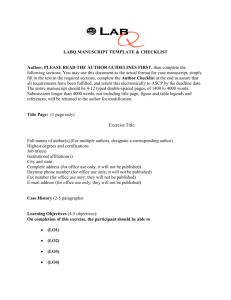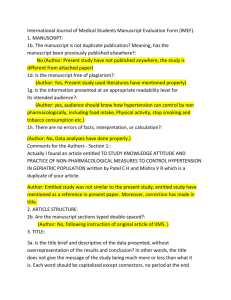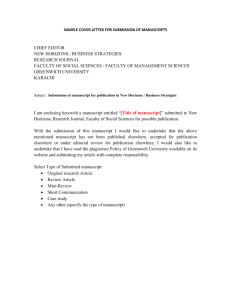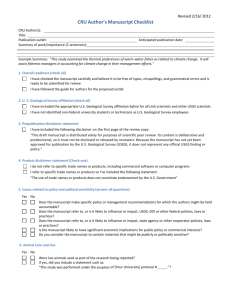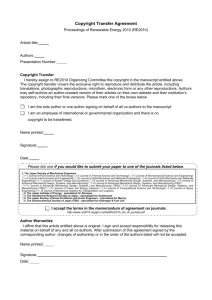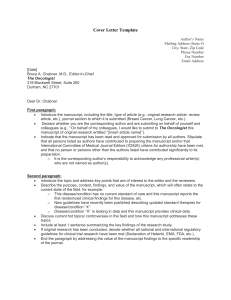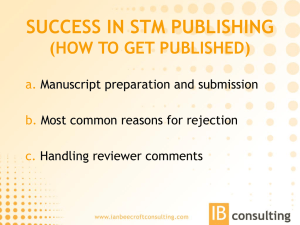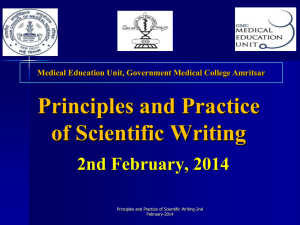Manuscript & Abstract Writing
advertisement
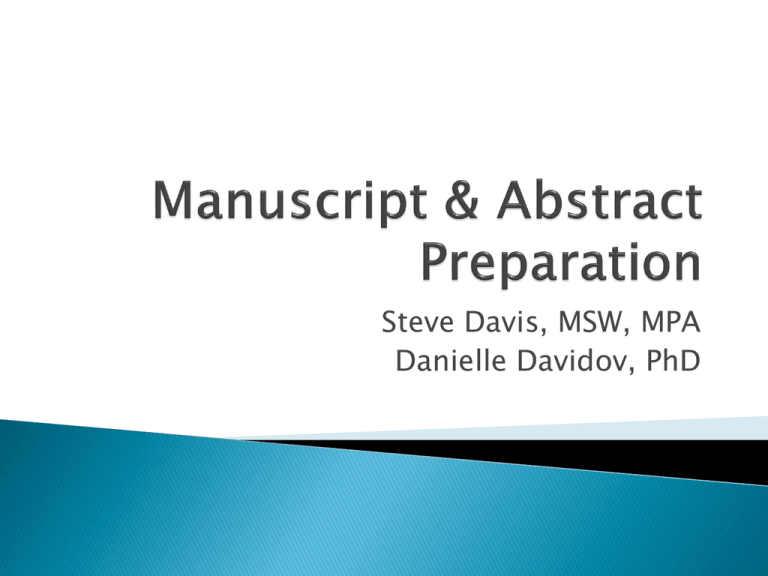
Steve Davis, MSW, MPA Danielle Davidov, PhD Once your research project is finished (or almost finished), you should be thinking about: 1) Submitting your research as an abstract to a scientific conference 2) Writing a manuscript for submission in a peerreviewed journal Four essential steps that occur prior to actual writing: 1) Finding and selecting a journal 2) Determining the article category 3) Examining the Instructions for Authors in detail 4) Obtaining a copy of the AMA Manual of Style A critical first step is identifying a journal that is the “best fit” for your project/paper. How? ◦ Locate a journal using popular lists ◦ Read the first part of the Instructions for Authors Locating a Journal and reading the first part of the author instructions. ◦ Popular Journal Lists by Specialty ◦ www.medbioworld.com ◦ www.pubmed.com Tip #1: One or two potential journals should be identified during the design stage Tip #2: Scan two or three recent journal editions for “hot topics” Tip #3: Examine the Instructions for Authors ◦ After you have identified a journal, you must determine the article category ◦ The category determines how the article is written ◦ Categories are usually topics like: Pediatrics Public Health Infectious Disease Imaging Etc. A manuscript’s topic is not within the journal’s scope The scope of a journal can change over time ◦ What a journal published ten years ago is not necessarily what it will publish today. If you are unsure if your topic is within the scope of a journal, email the editor and ask! This can save you a LOT of time and effort. The AMA Manual of Style Used by most medical journals. ◦ http://www.docstyles.com/amaguide.htm ◦ Exceptions are administrative journals which may use the APA or Chicago Manual of Style Writing the Manuscript Common Sections of a Manuscript ◦ ◦ ◦ ◦ ◦ ◦ ◦ ◦ Title Abstract Introduction Methods Results Discussion/Limitations Conclusions References The title should concisely and correctly convey the content of the article ◦ Other researchers may not be able to locate your article if the title does not convey the article’s substance. Do not exceed the specified length limits in the Instructions for Authors. ◦ Use the word processor to check. Shorter is better! The abstract is a brief summary of your entire article (no more than 250-500 words) Usually, it is one – two sentences from each section of the manuscript and it is written LAST It can be either: 1. Structured (Background, Objective, Methods, Results, Conclusions) 2. Unstructured (No subsections) Conference abstracts are similar to those in research manuscripts When submitting an abstract for a conference, you will want to include 1 – 2 sentences for each section: Background: Why is the topic important? Objective: Purpose of the study Methods: Type of study design, data analysis Results: Main findings, specific Conclusions: General findings, future directions Start with the background and end with the study objective and/or question 3 paragraphs (Background, Importance, Goals/Objectives) Must pass the “So what?” test Must be brief! Background: What is known? Importance: Why should anyone care? (Relevance to journals’ readers, i.e., emergency medicine) Goals/Objectives: What are we going to do to study it? Usually no more than 1 to 1.5 double spaced word processor pages. Background section ◦ Usually start off with an alarming statistic or something that is known as a fact to grab the reader’s attention: Ex) “Domestic violence is a pervasive public health problem” Ex) “Approximately 4.8 million rapes and sexual assaults are committed against women each year” Ex) “Overcrowding is a common problem faced in the emergency department” Expand upon the background of the problem by citing what previous research has been carried out on the topic ◦ Ex) “The past twenty years of research examining patient satisfaction in the emergency department has found three main components of satisfaction” Almost every sentence in the Background section should have AT LEAST one reference ◦ Unless: It is an original thought (not really common in research) It is something that is common knowledge After the background, you need to discuss why the topic is important and worth studying… ◦ Before you present the goal or purpose of your study, state why it is worth doing: Ex) “To the best of our knowledge, no study has examined this topic in rural patients…” Ex) “Literature is scarce on X, Y, and Z, and this important information has implications for clinical practice” At the very end of the introduction, state the purpose of your study Tell the reader your specific aims and your hypotheses ◦ Ex) “The aims of the current study were threefold: 1) to _________, 2) to __________, and 3) to ________. ◦ Ex) “The purpose of the current study was to examine emergency medicine physicians’ attitudes towards bedside ultrasound using a web-based survey.” ◦ Ex) “We hypothesize that emergency medicine physicians will have favorable attitudes towards bedside ultrasound.” 1. 2. Failure to carefully and clearly define a research question before a study is initiated. Too long. Do not make this section a book report or formal literature review. In this section you describe: ◦ The who, what, when, where, how and how many Participants (aka, sample) Instruments Procedures Data Analysis ◦ How many participants did you survey? ◦ What was the final response rate? ◦ How many patient charts were reviewed? ◦ What survey questions did you ask? ◦ Do your measures have reliability and validity? ◦ How did you send your surveys? ◦ How did you review patient charts? ◦ Which statistical procedures (e.g., logistic regression) and statistical packages (e.g., SAS, STATA, SPSS) were used to analyze the data? The Methods should: ◦ Contain enough information so that others can exactly replicate your study ◦ Be organized using subheadings (unless journal states otherwise) ◦ Mention IRB review and approval Tip: You can look at the methods sections of other manuscripts to get an idea about how much detail to include in this section In this section you will describe: The outcomes of the study ◦ Organize this section parallel to the methods section Start with demographics ◦ Use mostly tables and figures and limit text (< 4) Tables should be detailed enough so that they can stand alone without explanation and be understood Refer to a table for important results, only: Ex) “As can be seen in Table 1, there was a significant association between X and Y” ◦ Do NOT interpret the results, only present them 1. 2. 3. 4. Presentation of data in a misleading way or incongruence between tables and text Not all subjects enrolled in the study are accounted for in the tables or text Percentages in tables add up to more than 100% without explanation Tables and graphs are too complex to reproduce well In this section you: ◦ Link the results found in your study to other previous studies (should flow from general to specific) ◦ State conjectures regarding the reasons for your results in this section, but be careful to emphasize that it is your opinion ◦ Try to include all major studies regarding an issue ◦ Do not omit studies that have findings contrary to your own. Rather discuss why these findings might be different from your own. 1. 2. 3. Author conjectures about the results are presented as fact without evidence. The importance of the study is overestimated. All major previous studies are not included or discussed. 4. Too much time is spent on discussing or explaining commonly known or accepted ideas. 5. The limitations of the study are not mentioned (can be in a freestanding section). In this section you: ◦ Provide an answer to the research question and suggest a future direction ◦ Do not merely restate your study results ◦ Do not overstate the external applicability of your results ◦ Be sure to state the need for future study (if applicable) The references should list all works that you discuss or take ideas from in the manuscript ◦ Remember: unless you are stating an original thought or commonly known piece of information, you need a reference Tips: ◦ References should be current, if possible (within past 3–5 yrs) ◦ Format references using AMA style unless otherwise indicated ◦ Do not number the references while writing the manuscript!! Place author names and date in parentheses (i.e. Davis, 2006), then go back later and insert superscripts this will save you hours of work! ◦ Make sure every reference in your list has been matched with and mentioned in the text Use short sentences and avoid verbosity Use the active versus the passive voice ◦ Active “Research assistants enrolled eligible patients.” ◦ Passive “Eligible patients were enrolled by research assistants.” Minimize the use of abbreviations ◦ Spell out the full term the first time followed by the abbreviation in parentheses “The use of ultrasound (US) in emergency medicine has become…” thereafter, use the abbreviation The Review Process Cover Letter: ◦ Address to the editor of the journal ◦ List the title of the article ◦ Identify the journal category for which your manuscript is intended ◦ Identify the corresponding author ◦ Indicate study design ◦ Mention if the work was presented at a conference, if any conflicts of interest or copyright constraints exist Most journals now have an electronic submission process that cuts down on time to decision ◦ Google the name of the journal to find the submission website ◦ Upload title page, manuscript, cover letter, tables/figures, and indicate order of authorship Four decision types: 1. Accepted (extremely rare) 2. Accepted pending revisions 3. Revise and resubmit Make sure you address all review comments, even the ones you didn’t incorporate, in the revision cover letter 4. Rejected (more frequent that you might believe You might have to try 2 – 3 journals before it gets accepted – that’s okay! A publication is a publication. DeBehnke DJ, Kline JA, Shih RD; Research Committee of the Society for Academic Emergency Medicine. Research fundamentals: choosing an appropriate journal, manuscript preparation, and interactions with editors. Acad Emerg Med. 2001 Aug;8(8):844-50. Taylor DM, Brown AF. Analysis of the study design and manuscript deficiencies in research articles submitted to Emergency Medicine. Emerg Med (Fremantle). 2001 Dec;13(4):444-50. Biros MH. Advice to authors: getting published in Academic Emergency Medicine. Available at: http://www.aemj.org/misc/published.shtml Accessed February 20, 2006 Abu-Laban RB. The top 10 errors in EM research. Presented at: Society for Academic Emergency Medicine Annual Meeting; May 23rd, 2005; New York City, NY Writing and Publishing a Manuscript. Steve Davis. Emergency Medicine Grand Rounds. September 9, 2010. Start writing! Good luck!

